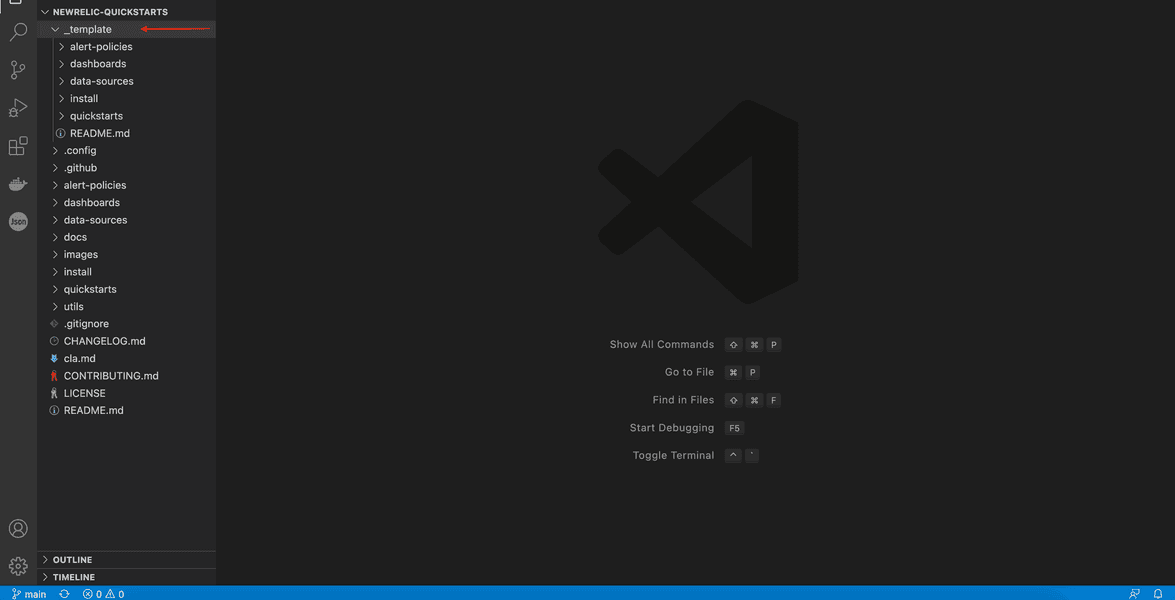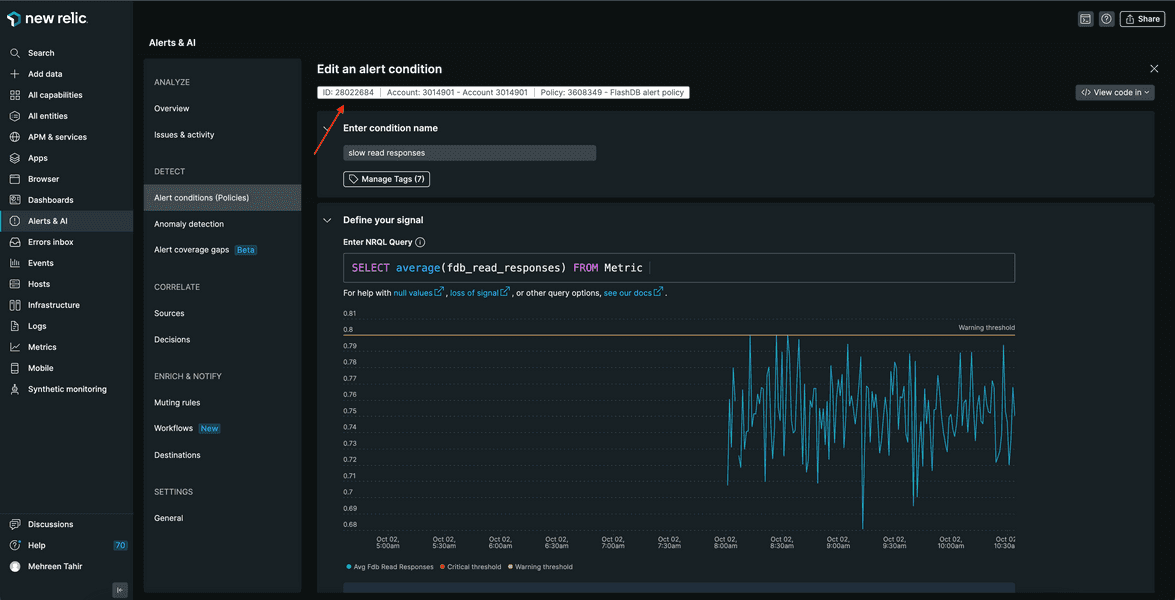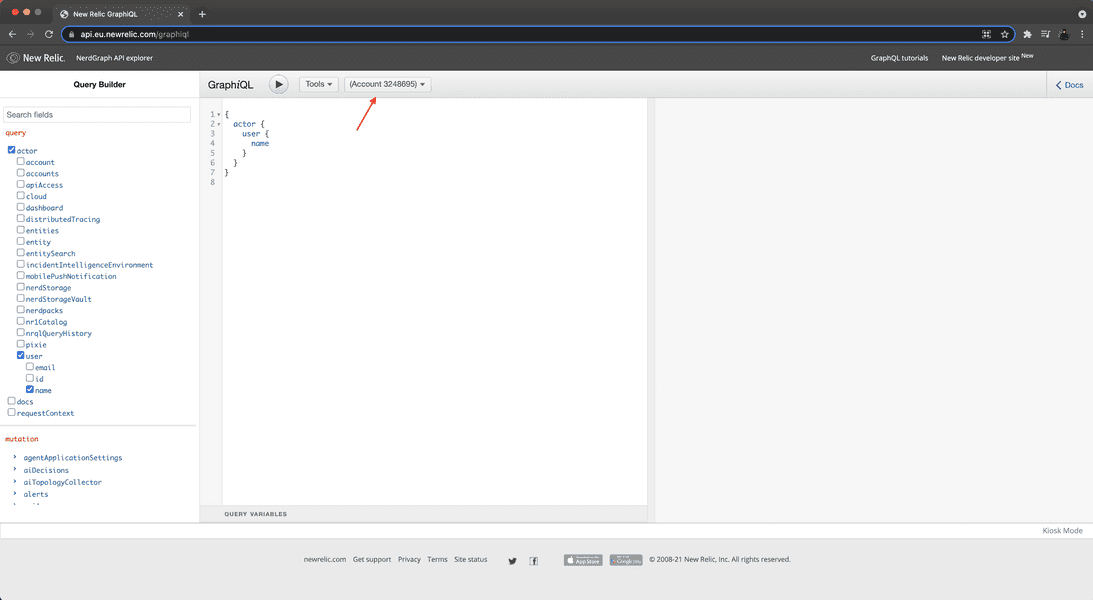Course
This procedure is a part of course that teaches you how to build a quickstart. If you haven't already, checkout the course introduction
As this procedure builds on top of the last ones in the lab, make sure you create alerts and understand the directory structure of quickstart before proceeding with this one.
In a previous procedure, you created alerts to notify you if there's any problem with FlashDB. Now, you add it to your quickstart so your users can use it too.
If you haven't already, fork the New Relic quickstarts repository and clone it to your local machine.
Open your Project in the IDE of your choice and navigate to _template directory.

Here, copy alert-policies/example-alert-policy directory and it's content to alert-policies directory at the root level. Rename the directory as flashdb.
This directory contains sample YAML files for static and baseline alerts to contribute the corresponding alerts to New Relic I/O. To help you populate your yaml files, you can use New Relic's NerdGraph API explorer to get a JSON representation of each alert condition.
Tip
NerdGraph is New Relic's GraphQL API.
Populate your alert configurations with NerdGraph
NerdGraph allows you to query your existing alerts and helps you configure them in your quickstart.
To populate your alert configurations with NerdGraph, you first need to look up its identifier.
Under your alert policy, click on the condition to get its ID.

With this identifier, you can now query your alert conditions and use the response to build out alert resources in your quickstart.
Query alert conditions in NerdGraph
Open the NerdGraph explorer and select your key from the dropdown menu.

Building a query is simple in the explorer. You check the appropriate boxes to build a GraphQL query or copy the following GraphQL query and paste it in the center pane of the explorer to query a static alert condition.
{ actor { account(id: REPLACE_ACCOUNT_ID) { alerts { nrqlCondition(id: REPLACE_CONDITION_ID) { ... on AlertsNrqlStaticCondition { id name nrql { query } } terms { operator priority threshold thresholdDuration thresholdOccurrences } } } } }}Here, you query AlertsNrqlStaticCondition for your condition's ID, name, query and more. These are the required fields you need to create the same alert in your quickstart.
Important
Make sure you replace your account ID and condition ID in the above query.
Execute the query to get a JSON representation of the specified condition.

Next, use this response to add a static alert to your quickstart.
Tip
Notice the checkboxes in the left-hand pane get checked when you paste the query in the explorer. This query returns the fields required to add an alert to the quickstart. If you've set custom fields or want to query more information, feel free to either edit the query in the center pane of the explorer or check the corresponding box in the left-hand pane.
From alert-policies/flashdb directory, rename static-alert.yml file to "SlowReadResponse.yml" and populate it with the data returned from above query.
# Name of the alertname: slow read response
# Description and detailsdetails: |+ This alert is triggered when read operation takes longer than 0.8.
# Type of alerttype: STATIC
# NRQL querynrql: query: "SELECT average(fdb_read_responses) FROM Metric"
# Function used to aggregate the NRQL query value(s) for comparison to the terms.threshold (Default: SINGLE_VALUE)valueFunction: SINGLE_VALUE
# List of Critical and Warning thresholds for the conditionterms:- priority: CRITICAL # Operator used to compare against the threshold. operator: ABOVE # Value that triggers a violation threshold: 0.9 # Time in seconds; 120 - 3600 thresholdDuration: 300 # How many data points must be in violation for the duration thresholdOccurrences: ALL
# Adding a Warning threshold is optional- priority: WARNING operator: ABOVE threshold: 0.8 thresholdDuration: 300 thresholdOccurrences: ALL
# Duration after which a violation automatically closes# Time in seconds; 300 - 2592000 (Default: 86400 [1 day])violationTimeLimitSeconds: 259200Here, you added a static alert condition to the quickstart.
To query your baseline condition, copy the following GraphQL query and paste it in the center pane of the explorer.
{ actor { account(id: 3014901) { alerts { nrqlCondition(id: 28068735) { ... on AlertsNrqlBaselineCondition { id name nrql { query } baselineDirection terms { priority threshold thresholdDuration thresholdOccurrences operator } violationTimeLimitSeconds } } } } }}Here, you query AlertsNrqlBaselineCondition for your condition's name, query, baselineDirection, and other fields required to add the condition to your quickstart.
Important
Make sure you replace your account ID and condition ID in the above query.
Execute the query to get the configuration data of your alert.

Next, use this response to add a baseline alert to your quickstart.
Tip
Notice the checkboxes in the left-hand pane get checked when you paste the query in the explorer. This query returns the fields required to add an alert to the quickstart. If you've set custom fields or want to query more information, feel free to either edit the query in the center pane of the explorer or check the corresponding box in the left-hand pane.
From alert-policies/flashdb directory, rename baseline-alert.yml file to "LowCacheHitRatio.yml" and populate it with the data returned from above query.
# Name of the alertname: low cache hit ratio
# Description and detailsdetails: |+ This alert is triggered whenever the cache hit ratio deviates 2 standard deviations from the normal.
# Type of alerttype: BASELINE
# NRQL querynrql: # Baseline alerts can use an optional FACET query: "SELECT sum(fdb_cache_hits)/sum(fdb_read_responses) FROM Metric"
# Direction in which baseline is set (Default: LOWER_ONLY)baselineDirection: LOWER_ONLY
# List of Critical and Warning thresholds for the conditionterms:- priority: CRITICAL # Operator used to compare against the threshold. operator: ABOVE # Value that triggers a violation threshold: 3 # Time in seconds; 120 - 3600, must be a multiple of 60 for Baseline conditions thresholdDuration: 300 # How many data points must be in violation for the duration thresholdOccurrences: ALL
# Adding a Warning threshold is optional- priority: WARNING operator: ABOVE threshold: 2 thresholdDuration: 300 thresholdOccurrences: ALL
# Duration after which a violation automatically closes# Time in seconds; 300 - 2592000 (Default: 86400 [1 day])violationTimeLimitSeconds: 259200Here, you added a baseline condition to the quickstart.
Lab
This procedure is a part of course that teaches you how to build a quickstart. Continue on to next procedure: add a data source.